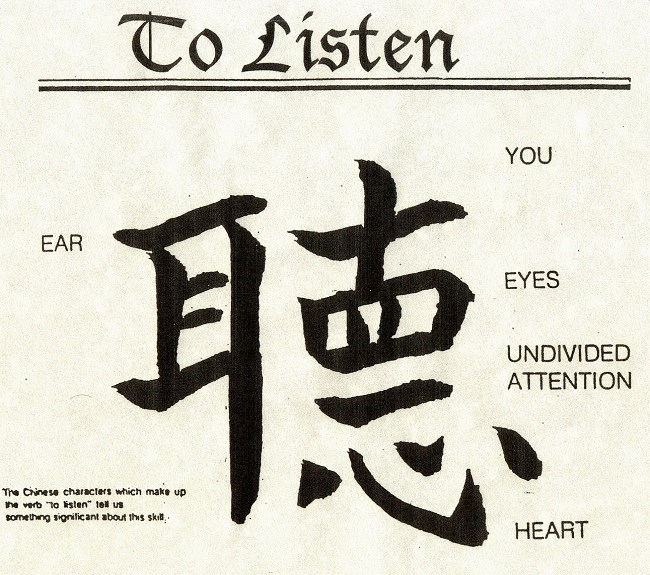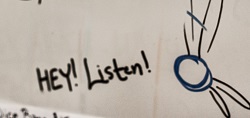Thankfully, Speaking and Listening have a prominent place in the new curriculum, so maybe it is timely to re-examine our own practice and check just how good we, as teachers, are at listening?
The way we listen to our children can have a very strong influence on the relationship we have with them. If you watch teachers (and people in general, actually) the majority listen with an intention to have their turn to speak: they are either talking at the same time as someone else, or preparing to speak at any moment.
If you manage to get the opportunity to observe someone else – or bravely have your own practice videoed and played back – which of these modes of listening do you see the most of?
Going through the motions - looking like you are listening: i.e. giving an overall impression of listening, but not fully engaged with the child who is speaking.
Skim Listening: Selecting parts of what is being said, usually picking out the bits that will satisfy the information you want to hear, but not hearing the fullness of the answer / conversation.
Analytic Listening: Listening attentively in order to make sure the child has an understanding about what you want them to know or do; but thinking of your next question as they are talking and jumping in with the follow up question very quickly, which interrupts their flow.
Empathetic Listening: Often associated with mediation and counselling this is very attentive listening, where body language and eye contact all come together to give the message that the speaker is very important and they have your undivided attention as you listen.
The Chinese have a symbol for Listening that captures all the skills of a really effective listener:

We instinctively feel the difference between someone who values what we are saying and someone who is going through the motions. Children feel that difference too. Good listening is critical for any teacher if they are to know what is going on in young learners’ minds. So listen up – what do you think you need to do to become a better listener?
Helping children become better listeners
In many thinking sessions up and down the country, teachers use the Chinese symbol for listening in their classrooms and discuss how it takes ALL of you to be a truly effective listener. I would urge you to do the same. But just talking about it once or twice and pointing to the poster on the wall is unlikely to have the impact you want and change the listening behaviours in your classroom.
Like anything else, some children find it more difficult to listen than others (which names just popped into your head, I wonder?). However, if we are serious about supporting them to become better listeners (and we should, rather than just getting exasperated and cross with them), then there needs to be an open and frank dialogue about listening expectations and some practical activities to help them understand more fully.
Is there a shared understanding of what you mean when you say ‘Listen’? Play a quick game of ‘Odd One Out’: Which is the odd one out between: hearing, listening and noticing: And why? Then discuss the implications of those differences in your own context.
When children are involved in a group / whole class discussion, give one or two children the job of ‘Listening Monitor’. Ask them to notice and describe (on a clipboard) when they see some good examples of people listening. Get them to give some feedback at the end. What have they observed? How can we all copy this behaviour? Those who are not so good at listening yet – what will you try first to become a bit better?
Ask children to draw some cartoon faces or make masks of facial expressions that depict ‘good listening’, how it feels to be ignored, or empathetic listening.
Play quick games to practise listening: e.g. two children sit back to back – one draws a simple line picture and then describes it to the other child who has to duplicate the drawing from the verbal only instructions.
Ask pairs of children to take turns talking to each other for just a minute on a given list of ideas, eg: ‘Your full name’, ‘Your favourite food’, ‘Your least favourite food’, ‘Something you are good at’.
The ‘listening’ child then has to ‘introduce’ their partner to someone else including all the information they have just been given.
Then swap over.
This can be adapted for giving instructions: Child 1 gives Child 2 a string of three or four instructions that they have to listen carefully to (you decide how many different steps in the instructions - depends on how old they are and how good their memories). The other child then has to mime/act out those instructions in the right order:
- Open the bathroom door
- Take out your toothbrush
- Move to the kitchen
- Put the kettle on
- Put your shoes on
- Eat your breakfast
Play lots of quick thinking games across the week: simple challenges that encourage children to swap ideas, and listen carefully to other points of view. Done in short bursts it makes ‘good listening’ more achievable for some children.
Demonstrate to them what disagreeing politely looks like and expect they will do the same ‘I disagree with Sam because…’ They must give reasons for what they think to show they have listened to others and have a counter argument that makes sense.
They might appear to be quite simple challenges: but are capable of stimulating a great deal of conversation – and that requires the skills of listening. Have a go yourself with a group of people and see what happens.
Example challenge:
Put these things in order of size: train, boat, aeroplane, bicycle, scooter, car, horse, bus, helicopter, motorbike.
- Put them in order of weight
- Put them in order of speed
- Put them in order of importance. (children have to decide what ‘important’ means.)
- Find one thing they all have in common
- Pick one and say why it is the odd one out
- Pick two that you think are connected in some way
This can be repeated with a host of different things: household appliances, wild animals, subjects in school.
Why not make it an aim for the coming weeks – to focus on and improve listening skills with your children? How will you know if things are improving? What will you and your children look for and reflect upon? Over to you…


















